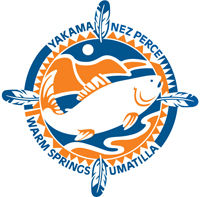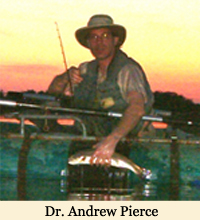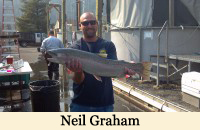 |
Partnership with Columbia River Inter-Tribal Fish Commission (CRITFC) |
The Columbia River Inter-Tribal Fish Commission (CRITFC) partnership with the Nagler lab received its fourth consecutive year of support for a project entitled "Captive reconditioning of Snake River kelt steelhead: understanding the physiology of post-spawning recovery and reproductive rematuration." Dr. Andrew Pierce, research scientist with CRITFC and adjunct professor at the University of Idaho (UI), is the primary investigator, with support from UI and CRITFC staff. The project collaborates extensively with the Nez Perce Tribe and the Yakama Nation.
Dr. Andrew Pierce, research scientist with CRITFC and adjunct professor at the University of Idaho (UI), is the primary investigator, with support from UI and CRITFC staff. The project collaborates extensively with the Nez Perce Tribe and the Yakama Nation.
Unlike other Pacific salmon species, steelhead (Oncorhynchus mykiss) do not necessarily die after spawning. Repeat spawning iteroparous fish are capable of increasing productivity of ESA-listed Columbia River Basin (CRB) steelhead populations. However, current iteroparity rates for CRB steelhead are considerably lower than historical rates, due to operation of the hydropower system and habitat degradation. Reconditioning post-spawned fish (kelts) in captivity is being evaluated as a restoration tool (poster).
We are working on developing and applying indices based on the endocrinology and physiology of reproduction, growth, and stress in fish to kelt steelhead in captive reconditioning programs. Our goal is to achieve a detailed understanding of the physiology of reconditioning. This knowledge will provide a scientific basis for maximizing the success of kelt reconditioning programs. For example, measurement of plasma hormone levels in kelt steelhead has revealed that both the consecutive spawning and skip spawning life-history types are produced by reconditioning projects (poster). Projects include establishing post-spawning rainbow trout as a model for studying reconditioning in kelt steelhead, establishing a hatchery model of Snake River B-run kelt steelhead, comparing reconditioning profiles of kelt steelhead at different locations in the CRB, and investigating the effects of drugs, diets, and other interventions on the survival and rematuration of kelt steelhead.
and stress in fish to kelt steelhead in captive reconditioning programs. Our goal is to achieve a detailed understanding of the physiology of reconditioning. This knowledge will provide a scientific basis for maximizing the success of kelt reconditioning programs. For example, measurement of plasma hormone levels in kelt steelhead has revealed that both the consecutive spawning and skip spawning life-history types are produced by reconditioning projects (poster). Projects include establishing post-spawning rainbow trout as a model for studying reconditioning in kelt steelhead, establishing a hatchery model of Snake River B-run kelt steelhead, comparing reconditioning profiles of kelt steelhead at different locations in the CRB, and investigating the effects of drugs, diets, and other interventions on the survival and rematuration of kelt steelhead.
 Dr. Andrew Pierce, research scientist with CRITFC and adjunct professor at the University of Idaho (UI), is the primary investigator, with support from UI and CRITFC staff. The project collaborates extensively with the Nez Perce Tribe and the Yakama Nation.
Dr. Andrew Pierce, research scientist with CRITFC and adjunct professor at the University of Idaho (UI), is the primary investigator, with support from UI and CRITFC staff. The project collaborates extensively with the Nez Perce Tribe and the Yakama Nation.Unlike other Pacific salmon species, steelhead (Oncorhynchus mykiss) do not necessarily die after spawning. Repeat spawning iteroparous fish are capable of increasing productivity of ESA-listed Columbia River Basin (CRB) steelhead populations. However, current iteroparity rates for CRB steelhead are considerably lower than historical rates, due to operation of the hydropower system and habitat degradation. Reconditioning post-spawned fish (kelts) in captivity is being evaluated as a restoration tool (poster).
We are working on developing and applying indices based on the endocrinology and physiology of reproduction, growth,
 and stress in fish to kelt steelhead in captive reconditioning programs. Our goal is to achieve a detailed understanding of the physiology of reconditioning. This knowledge will provide a scientific basis for maximizing the success of kelt reconditioning programs. For example, measurement of plasma hormone levels in kelt steelhead has revealed that both the consecutive spawning and skip spawning life-history types are produced by reconditioning projects (poster). Projects include establishing post-spawning rainbow trout as a model for studying reconditioning in kelt steelhead, establishing a hatchery model of Snake River B-run kelt steelhead, comparing reconditioning profiles of kelt steelhead at different locations in the CRB, and investigating the effects of drugs, diets, and other interventions on the survival and rematuration of kelt steelhead.
and stress in fish to kelt steelhead in captive reconditioning programs. Our goal is to achieve a detailed understanding of the physiology of reconditioning. This knowledge will provide a scientific basis for maximizing the success of kelt reconditioning programs. For example, measurement of plasma hormone levels in kelt steelhead has revealed that both the consecutive spawning and skip spawning life-history types are produced by reconditioning projects (poster). Projects include establishing post-spawning rainbow trout as a model for studying reconditioning in kelt steelhead, establishing a hatchery model of Snake River B-run kelt steelhead, comparing reconditioning profiles of kelt steelhead at different locations in the CRB, and investigating the effects of drugs, diets, and other interventions on the survival and rematuration of kelt steelhead.